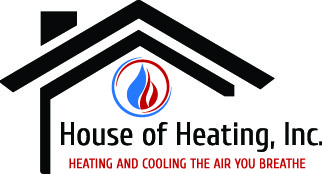
Every floor in your home should be a refuge that’s warm and toasty in the winter and cool and comfortable in the summer. However, owners of some two-story homes find the upper floor is stubbornly hotter or colder than the main floor.
This could just be because most thermostats in a house are on the first floor, which is where people spend the most time—in the living room, kitchen, etc.—so they set the temperature according to how it feels on the first floor.
However, temperature discrepancies between the upstairs and downstairs could also be due to problems with your HVAC system. Some of these issues can be solved fairly quickly while others might require more extensive and costly fixes. Here, the professionals at House of Heating Incorporated will help you solve why the upstairs of your home is hotter than downstairs, or vice versa.
Why Is It Hot Upstairs?
The phenomenon of the upstairs of a two-story home feeling hotter than the downstairs can be traced to several factors. First, heat rises, so it’s natural for the second floor of a home to get hotter than the main floor. Poor insulation in the attic or roof can make this worse by letting heat transfer from the roof into the upstairs rooms.
Another common reason is that the air conditioning is not big enough to cool the entire home, causing it to struggle to cool the upstairs adequately.
To deal with these issues, homeowners could add additional insulation in the attic and make sure their home has proper ventilation. If there’s a possibility the AC is the correct size for the home, call an experienced HVAC company like House of Heating Incorporated inspect the unit. A knowledgeable professional also can help select a unit that's better suited for your home if you are considering air conditioning installation or replacement.
Why Is My Upstairs So Cold/Not Heating?
When the downstairs of your home is warm, but it’s very cold upstairs, that makes for a frosty night for anyone whose bedrooms are on the upper floor. The most frequent reasons an upstairs not heating like it ought to are the insulation levels and the ductwork.
Inadequate insulation permits cold air to filter through the home’s attic or walls and contribute to heat loss, causing colder temperatures on the upper levels. It’s essential to make sure your home has a thick, level layer of insulation in the attic and proper insulation in the walls to keep the cold out and the heat inside.
The ductwork in a home plays a critical role in distributing conditioned air throughout different locations of the building. However, issues with the ductwork can result in the upstairs being colder than the lower floor. A typical explanation for this is improper airflow balance. The ducts may not be the correct size or design, resulting in an uneven distribution of air between the floors. This can cause more warm air to flow downstairs, leaving insufficient airflow—which is the heated air—on the upper story.
Another factor with ductwork is the layout of the supply and return vents. If there are fewer vents on the upper story or they aren't well installed, it can limit air circulation and cause substandard heating or cooling. In addition, leaks or gaps in the ductwork can allow air loss, lowering the overall efficiency of the HVAC system and exacerbating the temperature difference.
To find out why the upstairs is colder than the downstairs, homeowners should hve their ductwork inspected by trusted experts like the team at House of Heating Incorporated to identify any imbalances, leaks or inadequacies. Sealing leaks and installing additional vents or adjusting existing ones can help increase airflow and ensure a better temperature balance between the upstairs and downstairs.
How You Can Fix a Hot or Cold Upstairs?
If your upstairs is hotter or colder than the ground level of your house, an HVAC zoning system could be a great solution.
An HVAC zoning system breaks the household into distinct zones, which each have their own thermostat and damper system so the homeowner can modify the heating or cooling of each zone.
This system can be very beneficial in scenarios where the upstairs of a multi-story home is quite hot or too cold while the main floor is comfortable. By setting up a zoning system, homeowners can manage the temperature independently in each zone, enabling them to address specific hot or cold spots effortlessly.
To find out more about an HVAC zoning system in Marshfield, call House of Heating Incorporated. We’ve created and installed customized home comfort plans for many community members and are happy to show how an HVAC zoning system could enhance the comfort in your home.
Why Is the Humidity So High Upstairs?
In addition to the upper story being hotter or colder than the rest of the house, another issue in multi-floor homes is when the upstairs is more humid than the lower level.
A frequent explanation for excess upper floor humidity is poor ventilation on the upper floor, which can produce higher humidity levels. As is often the case with temperature differences between floors, insufficient insulation or sealing in the attic or walls may permit warm, humid air from outside infiltrate the upstairs rooms. Plus, if there are any leaks or plumbing problems on the upper floor, that can also lead to excess moisture in that section of a home.
To correct humidity problems, homeowners can add more ventilation by using fans or opening windows to promote airflow. Appropriate levels of insulation in the attic and better sealing the attic and walls can help prevent external moisture from entering the upstairs. Locating and repairing any leaks or plumbing issues is also imperative.
Depending on the levels of moisture found in the home, a whole-home dehumidifier could be another valuable tool to manage humidity on the upper and lower floors.
